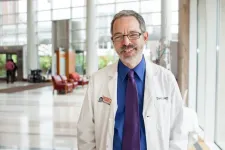(Press-News.org) New study makes novel use of plant biomarkers preserved in sediment to reconstruct methane cycling over the past 10,000 years
Plant waxes hold an isotopic signature of ancient methane
As planet warmed due to slow changes in Earth’s orbit, lakes produced increased amounts of methane, which is a potent greenhouse gas
Researcher: ‘Living on a warming planet, we can look to these signs from the past to predict our future’
EVANSTON, Ill. — By studying fossils from ancient aquatic plants, Northwestern University and University of Wyoming (UW) researchers are gaining a better understanding of how methane produced in Arctic lakes might affect — and be affected by — climate change.
In a new study, the researchers examined the waxy coatings of leaves preserved as organic molecules within sediment from the early-to-middle Holocene, a period of intense warming that occurred due to slow changes in Earth’s orbit 11,700 to 4,200 years ago. These wax biomarkers — which were once a part of common aquatic brown mosses — were preserved in sediment buried beneath four lakes in Greenland.
By studying these biomarkers, the researchers discovered that past warming during the middle Holocene caused lakes across a wide range of Greenland’s climates to generate methane. Because methane is a more potent greenhouse gas than carbon dioxide, any changes in methane production with warming are important to understand.
Currently, researchers have incomplete knowledge of how much methane is produced in Arctic lakes and how ongoing warming will affect methane production. The new study suggests that warming potentially could lead to a previously under-appreciated flux in methane emissions from lakes.
The study will be published on Friday (Sept. 29) in the journal Science Advances.
“Last time Greenland lakes experienced major warming, we were coming out of the last ice age, and it took some time for the conditions to develop for lake methane cycling to increase,” said Jamie McFarlin, who led the study. “But once it developed, the lakes in our study maintained an intensified methane cycle for thousands of years until the onset of the naturally driven late Holocene cooling. This supports a climate dependence on lake methane cycling in some Arctic lakes.”
“These data show increased periods of methane cycling during past warm periods,” added Magdalena Osburn, the study’s senior author. “Living on a warming planet, we can look to these signs from the past to help predict our future. We suspect this process is going to become more and more important in the future of these lakes.”
When the research began, McFarlin was a Ph.D. student at Northwestern; now she is an assistant professor at UW. Osburn is an associate professor of Earth and planetary sciences at Northwestern’s Weinberg College of Arts and Sciences. Osburn co-advised McFarlin with Yarrow Axford, William Deering Professor in Geological Sciences at Weinberg College and the paper’s second author.
Lakes act as significant natural sources of methane, but exactly how much methane production will change with ongoing warming within Arctic lakes is not fully quantified. And because Arctic and boreal landscapes are the fastest warming regions on Earth, it is imperative for researchers to better understand the dynamics between warming temperatures and methane production in these lakes.
To explore these dynamics, the researchers produced new data at two lakes (Wax Lips Lake and Trifna Sø) and reviewed published data from two additional lakes on Greenland (Lake N3 and Pluto Lake). They compared the hydrogen isotopic composition of aquatic plant waxes within the sediment to biomarkers from terrestrial plants and other sources. The isotopic composition of biomarkers from aquatic plants revealed a signature from methane during the early-middle Holocene at most sites.
Because these plants absorb methane, they might mitigate some of the methane produced in lakes before it is emitted into the atmosphere.
“In the lakes in our study, some methane was taken up by aquatic mosses living in the lakes — likely through a symbiotic association with a type of bacteria that eats methane,” McFarlin said. “We do not know yet how much methane was produced versus consumed in these lakes during the time period of our study, so the overall effect on the atmosphere remains unclear. The uptake of methane into plants is likely restricted to very specific types of aquatic mosses, however, so not all lakes or even all Arctic lakes will have these same dynamics.”
“The Arctic has huge areas covered in lakes,” Axford said. “Not every lake has mosses that will record methane dynamics, but our study also highlights that those vast swaths of Arctic lakes are vulnerable to climate-driven changes in methane cycling, whether mosses are on site to witness those changes or not. This is yet another way that rapid warming in the Arctic could affect global climate.”
The study, “Aquatic plant wax hydrogen and carbon isotopes in Greenland lakes record shifts in methane cycling during past Holocene warming,” was supported by the National Science Foundation (NSF) Division of Polar Program awards, an NSF Graduate Research Fellowship, Northwestern’s Paula M. Trienens Institute for Sustainability and Energy and a Geological Society of America Graduate Research Award.
END
Up to 15 percent of children and five percent of adults are affected by the chronic inflammatory skin disease atopic dermatitis. Despite advanced therapy measures, the severe itching and eczema, especially on the elbows or knees, cause great distress to the patients. In the course of a study conducted at MedUni Wien a research team led by Wolfgang Weninger, Head of the Department of Dermatology, has discovered a new approach: bacteriophages, which colonize the skin as viral components of the microbiome and can drive the development of innovative ...
Leesburg, VA, September 29, 2023—According to the American Journal of Roentgenology (AJR), using a 6-mm threshold, rather than a 5-mm threshold, helps facilitate better risk stratification and treatment decisions in patients with nasopharyngeal carcinoma (NPC).
“Future American Joint Committee on Cancer (AJCC) staging updates should consider incorporation of the 6-mm threshold for N-category and tumor-stage determinations,” wrote corresponding author Zhiying Liang, MD, from the radiology department at China’s Sun Yat-sen University Cancer Center.
This AJR accepted manuscript by Liang et al. included ...
ROCKVILLE, MD – The Biophysical Society is honored to celebrate Kandice Tanner, a physicist and Senior Investigator at the Center for Cancer Research, National Cancer Institute (NCI), National Institutes of Health (NIH) in Bethesda, Maryland. Tanner is being recognized for her pioneering work on the biophysics of the metastatic spread of cancer.
Using 3D organoid models of cancer progression, Tanner discovered a novel type of cell migration and cell generated forces associated with the formation of microtissues and tumors. This discovery demonstrated that physical forces are important in the establishment ...
September 29, 2023, CLEVELAND: A team from Cleveland Clinic has developed a new model for prioritizing patients waiting for a lung transplant, aimed at improving outcomes and reducing deaths among those in need of donor lungs. The new method offers an improved strategy for organ allocation by taking into account how the time a patient has spent on the waiting list could impact the severity of their disease and the urgency of their need for a transplant.
The results of a study looking at this new method were published today in The American Journal of Respiratory and Critical Care Medicine.
Currently, ...
The University of Virginia School of Medicine’s Mariano A. Garcia-Blanco, MD, PhD, will be inducted this weekend into the American Academy of Arts and Sciences (AAAS), one of the country’s oldest and most prestigious honorary societies, in recognition of his exceptional scientific contributions.
The AAAS was founded in 1780 – during the Revolutionary War – by John Adams, John Hancock and other founding fathers who wanted to “cultivate every art and science which may tend to advance the interest, honor, dignity and ...
URBANA, Ill. — As we hurtle toward crucial tipping points on a warming planet, an international team of scientists is recruiting a surprising ally to make a powerful dent in greenhouse gas emissions: the cow. Animal sciences researchers from the University of Illinois Urbana-Champaign are driving a new project to reduce methane production resulting from rumen fermentation in beef and dairy cattle. The 3-year, $3.2-million project is part of the Greener Cattle Initiative, led by the Foundation for Food and Agriculture Research (FFAR).
According to the researchers, aggressively targeting methane could help course-correct our climate trajectory on a quicker timeline ...
WASHINGTON, D.C. — The U.S. Department of Energy (DOE) today announced $264 million in funding for 29 projects to develop solutions for the scientific challenges underlying DOE’s Energy Earthshots™ Initiative to advance clean energy technologies within the decade. The funding will support 11 new Energy Earthshot Research Centers led by DOE National Laboratories and 18 university research teams addressing one or more of the Energy Earthshots™ that are focused on six different areas, including industrial decarbonization, carbon storage, and offshore wind. The Department launched the Energy Earthshots ...
A top UVA Health cancer expert is highlighting how a new drug could transform how doctors treat a brain tumor that typically strikes younger people.
David Schiff, MD, the co-director of UVA Cancer Center’s Neuro-Oncology Center, has authored an editorial in the prestigious New England Journal of Medicine describing the potential significance of the drug vorasidenib for patients with tumors known as “grade 2 IDH-mutant gliomas.” The drug, when tested in the INDIGO clinical trial, was found to slow tumor growth significantly and extended the average time until the tumor started growing from 11.1 months ...
An international team of researchers has released a landmark study on contemporary evolutionary change in natural populations. Their study uses one of the largest genomic datasets ever produced for animals in their natural environment, comprising nearly 4,000 Darwin’s finches. The study has revealed the genetic basis of adaptation in this iconic group. The results are published in the journal Science.
Ever since Darwin wrote about the finches of the Galápagos Islands, biologists have studied these small songbirds to understand the mechanisms of evolution. One ancestral species has evolved into 18 different species in the last million years. ...
Chemical engineering researchers have a powerful new tool at their disposal: active machine learning. In a recent perspective article published in Engineering, Kevin M. Van Geem’s research team at Ghent University explores the potential of active machine learning in revolutionizing the field of chemical engineering. By combining machine learning with the design of experiments, active machine learning promises to enhance the efficiency and cost-effectiveness of research, spanning all length scales of chemical engineering.
Active machine learning algorithms ...







